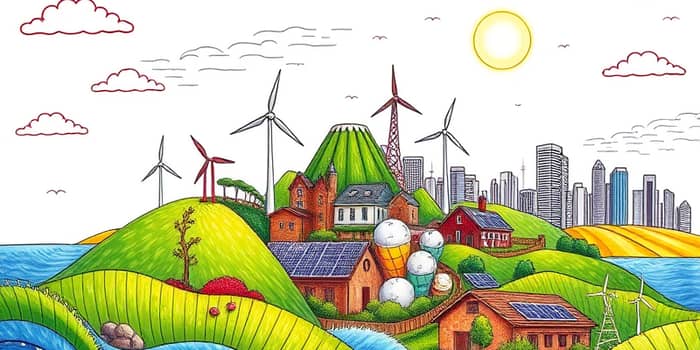
As global markets confront the realities of climate change, extreme weather, and nature loss, sustainable finance has moved into mainstream markets. Investors, institutions, and policymakers recognize that environmental and social risks now threaten traditional portfolios. This convergence of purpose and profit underscores a new era: one where financial returns and ecological resilience go hand in hand.
In 2024, sustainable debt issuance topped $1 trillion for the fifth consecutive year, driving the total sustainable bond market above $9.2 trillion. Despite geopolitical headwinds and policy uncertainty, capital continues to flow toward green, social, sustainability, and sustainability-linked instruments. Yet, meeting the United Nations Sustainable Development Goals by 2030 demands an additional $4 trillion annually—an urgent call to expand and innovate financing mechanisms.
Over the past decade, investor momentum has intensified as risk assessment evolves beyond credit ratings. Traditional portfolios now face pressure from rising insurance costs, asset write-downs, and regulatory fines tied to environment-related disclosures. Against this backdrop, financial institutions embed climate risk into asset valuation and deploy capital for resilience-building projects.
Today’s market growth spans sectors: food systems, nature-based solutions, industry decarbonization, and resilient infrastructure. Sustainability-linked loans and bonds (SLLs, SLLBs) offer flexible, performance-based frameworks that reward issuers for achieving emission reduction targets or biodiversity gains. Meanwhile, green bonds retain dominance, especially in Europe, APAC, and the Sovereign, Supranational, and Agency (SSA) spaces.
Innovation fuels the next wave of sustainable finance, creating instruments that channel capital toward pressing environmental challenges. Below are some of the most transformative developments:
Stricter disclosure rules and labeling standards now govern what qualifies as green or sustainable. The European Union’s ESG fund regulations mandate exclusions of fossil fuels and weapons, while Canada’s Bill C-59 and ISSB climate disclosure guidelines tighten reporting requirements. These frameworks aim to ensure that capital allocation drives real environmental impact and economic resilience.
Governments play pivotal roles. China and the United Kingdom advance ISSB-aligned standards, whereas some US and EU states have paused or scaled back ESG policies. Meanwhile, the EU Carbon Border Adjustment Mechanism and Japan’s GX Promotion Act create new incentives for low-carbon trade and investment.
The sustainable finance landscape varies by region, shaped by policy, market demand, and public-sector involvement:
In Europe, €421 billion in ESG euro credit and loan markets were issued in the first seven months of 2025. Sovereign and supranational issuers alone accounted for €183 billion, with green bonds leading.
APAC markets report rapid growth in transition debt. Japan’s sovereign issuance comprised 87% of national sustainable debt in 2024, while Australia, Thailand, and China roll out new frameworks to attract global capital.
SSA bonds reached $530 billion in issuance, and multilateral development banks pledged $120 billion annually by 2030, targeting climate mitigation and adaptation in vulnerable economies.
Leading investors integrate sustainability at the core of portfolio construction. Going beyond exclusionary screening, they target decarbonization pathways, resilience-building assets, and nature capital exposures. Data-driven insights and standardized metrics ensure that strategies deliver measurable environmental outcomes alongside financial returns.
Investors seek to capture the upside of early adoption, positioning in sectors poised for growth—nature-positive agriculture, digital infrastructure, and climate-resilient real assets. Collaboration with development finance institutions and de-risking mechanisms enables entry into high-impact markets.
Despite robust growth, sustainable finance faces headwinds. Some sustainability-linked formats experienced issuance declines, and the expected greenium premium has yet to materialize consistently. More concerning is the persistence of greenwashing, prompting regulators to tighten oversight and clamp down on misleading claims.
To bolster credibility, market participants adopt rigorous impact measurement frameworks, third-party verification, and clearer taxonomy alignment. Transparency and accountability become essential to maintaining investor confidence and ensuring long-term success.
The path ahead for sustainable finance is filled with both challenges and opportunities. Meeting infrastructure needs and nature-based transitions could unlock $10 trillion in annual business value and generate nearly 400 million jobs by 2030. Achieving the SDGs demands scaled private capital mobilization, underpinned by innovative instruments and de-risking strategies.
Early movers in nature capital, digital infrastructure, and transition finance will shape market standards and capture above-market returns. By integrating sustainability into core investment processes and embracing emerging tools, investors can build resilient, low-carbon portfolios for the future.
The promise of sustainable finance lies not only in mitigating risk but in unlocking a new paradigm of value creation—one where financial success and planetary health progress together.
References





